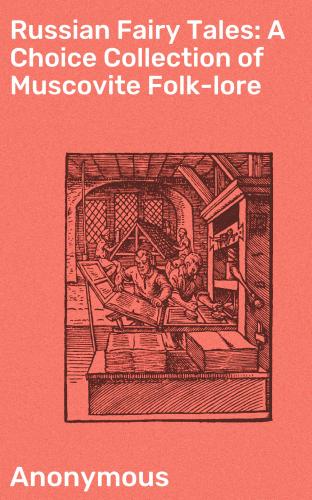Anonymous
Russian Fairy Tales: A Choice Collection of Muscovite Folk-lore
Published by Good Press, 2019
EAN 4057664139160
Table of Contents
Principal Incarnations of Evil.
Miscellaneous Impersonifications.
PREFACE.
The stories contained in the following pages are taken from the collections published by Afanasief, Khudyakof, Erlenvein, and Chudinsky. The South-Russian collections of Kulish and Rudchenko I have been able to use but little, there being no complete dictionary available of the dialect, or rather the language, in which they are written. Of these works that of Afanasief is by far the most important, extending to nearly 3,000 pages, and containing 332 distinct stories—of many of which several variants are given, sometimes as many as five. Khudyakof’s collection contains 122 skazkas—as the Russian folk-tales are called—Erlenvein’s 41, and Chudinsky’s 31. Afanasief has also published a separate volume, containing 33 “legends,” and he has inserted a great number of stories of various kinds in his “Poetic views of the Old Slavonians about Nature,” a work to which I have had constant recourse.
From the stories contained in what may be called the “chap-book literature” of Russia, I have made but few extracts. It may, however, be as well to say a few words about them. There is a Russian word lub, diminutive lubok, meaning the soft bark of the lime tree, which at one time was used instead of paper. The popular tales which were current in former days were at first printed on sheets or strips of this substance, whence the term lubochnuiya came to be given to all such productions of the cheap press, even after paper had taken the place of bark.[1]
The stories which have thus been preserved have no small interest of their own, but they cannot be considered as fair illustrations of Russian folk-lore, for their compilers in many cases took them from any sources to which they had access, whether eastern or western, merely adapting what they borrowed to Russian forms of thought and speech. Through some such process, for instance, seem to have passed the very popular Russian stories of Eruslan Lazarevich and of Bova Korolevich. They have often been quoted as “creations of the Slavonic mind,” but there seems to be no reason for doubting that they are merely Russian adaptations, the first of the adventures of the Persian Rustem, the second of those of the Italian Buovo di Antona, our Sir Bevis of Hampton. The editors of these “chap-book skazkas” belonged to the pre-scientific period, and had a purely commercial object in view. Their stories were intended simply to sell.
A German version of seventeen of these “chap-book tales,” to which was prefixed an introduction by Jacob Grimm, was published some forty years ago,[2] and has been translated into English.[3] Somewhat later, also, appeared a German version of twelve more of these tales.[4]
Of late years several articles have appeared in some of the German periodicals,[5] giving accounts or translations of some of the Russian Popular Tales. But no thorough investigation of them appeared in print, out of Russia, until the publication last year of the erudite work on “Zoological Mythology” by Professor Angelo de Gubernatis. In it he has given a summary of the greater part of the stories contained in the collections of Afanasief and Erlenvein, and so fully has he described the part played in them by the members of the animal world that I have omitted, in the present volume, the chapter I had prepared on the Russian “Beast-Epos.”
Another chapter which I have, at least for a time, suppressed, is that in which I had attempted to say something about the origin and the meaning of the Russian folk-tales. The subject is so extensive that it requires for its proper treatment more space than a single chapter could grant; and therefore, though not without reluctance, I have left the stories I have quoted to speak for themselves, except in those instances in which I have given the chief parallels to be found in the two collections of foreign folk-tales best known to the English reader, together with a few others which happened to fall within the range of my own reading. Professor de Gubernatis has discussed at length, and with much learning, the esoteric meaning of the skazkas, and their bearing upon the questions to which the “solar theory” of myth-explanation has given rise. To his volumes, and to those of Mr. Cox, I refer all who are interested in those fascinating enquiries. My chief aim has been to familiarize English readers with the Russian folk-tale; the historical and mythological problems involved in it can be discussed
